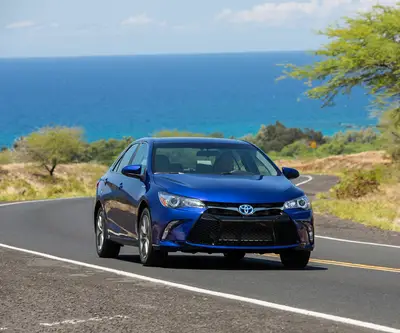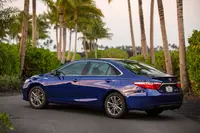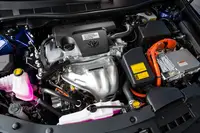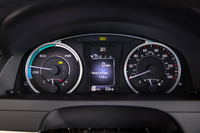2015 Toyota Camry Hybrid SE Review by Carey Russ +VIDEO
 2015 Toyota Camry Hybrid |
Hybrid Efficiency In A In A Good Looking Sedan-Sized Package
DRIVING DOWN THE ROAD WITH CAREY RUSS
• SEE ALSO: Toyota Buyers Guide
 2015 Toyota Camry Hybrid |
With all of the changes -- exterior and interior styling, interior materials, and chassis reinforcement -- to the 2015 Toyota Camry, and the debut of the sportiest model yet, the XSE, the Hybrid almost seems to disappear. It's still with us, and after a week with one I can say it's better than ever.
Yes, "Prius" is nearly synonymous with "Toyota hybrid", and the Prius Liftback and V offer exceptional space-efficiency in addition to making a hybrid statement. But Toyota is all about choice, and for those who don't want a Prius but do want a hybrid there is the Camry Hybrid, offered in LE, SE, and XLE grades. It gets the same bold restyling and revision inside and out as its regular siblings, and goes further on a gallon of unleaded regular. Thanks to an engine upgrade a few years back, it also has more power than in its original form, for improved acceleration with no detriment to fuel economy.
 2015 Toyota Camry Hybrid |
Maximum system horsepower is now 200, noticeably better than the original 187. I averaged 35 mpg for my week, the same as I got from a 2009 version with the old engine and slightly better than the 34 from a 2007 model. EPA estimates have changed over the years, mostly by changing methodologies. And EPA estimates for hybrids have never seemed to close to real-world results to me. Possibly that has to do with my living where steep hills and cut-throat traffic are normal and large expanses of level ground are far away. That 35 is still 10 mpg better than the V6 XSE I tested recently, and likely five or so better than from a four-cylinder. With the 17-gallon tank, that's nearly 600 miles between fuel stops.
My test car was an SE, with key options being the Entune Premium Audio with Navigation and App Suite, as comprehensive as its name is long, a moonroof, and wireless charging, a convenience if your electronic devices are so-equipped. Mine aren't. Even without options and in LE form, the level of comfort and convenience is high, and with better acceleration than the four-cylinder equivalent, the Hybrid presents no challenge in traffic. Regenerative braking adds braking power, and is especially useful descending long, steep grades. Save the regular brakes and recharge the battery! The original Camry Hybrid, 2007-2011, was overly soft in suspension to the point of being the definition of understeer. That was fixed with the 2012 generation, and has been further refined this year. It's a pleasant car with excellent fuel economy that just happens to be a gasoline-electric hybrid. No compromises necessary.
APPEARANCE: The overall shape is familiar, and immediately recognizable as a Camry, but everything under the roof is different. Unsurprisingly it looks like the larger, older sibling of the latest Corolla, with leaner, more mature proportions. Like its gas-only equivalent, the SE Hybrid gets a black mesh main grille for a sportier look than the chrome bars used on other models. Foglamps are in faux brake ducts to the side of the grille, and prominent lower fascia corner extensions add a performance look without unduly low clearance. The easiest way to tell a Hybrid? Look for the badging on the front fenders and the tail panel. And there's blue trim in the "T" badge logo.
 2015 Toyota Camry Hybrid |
COMFORT: Difference between a regular Camry and Hybrid of the same grade? Because of its hybrid battery pack, the Hybrid's rear seat back doesn't fold quite as usefully. And the trunk loses a couple of cubic feet of capacity. Two non-issues, and there is a space-saver spare under the trunk floor. Cheap-looking plastics were removed for the 2012 model change, and interior quality has continued to improve since then. Soft-touch textured materials make up most close surfaces, and the design is pleasant and comfortable. Standard equipment levels are high, with even the LS having dual-zone automatic climate control, a backup camera, tilt- and telescope-adjustability of the steering wheel (which has audio and phone controls), and brightly-lit "Optitron" main instruments. My SE being the mid-grade offering meant SofTex®-trimmed fabric seats, with eight-way power adjustment for the driver's and four-way manual adjustment for the front passenger and leather covering for the steering wheel rim and shift knob. Seat comfort is very good in front, and in the rear as well. Thanks to a near-flat floor and minimal contouring, the rear bench is more suitable for three passengers than is usual in the midsize sedan class. Useful storage abounds, with space plus water bottle storage in all doors, a toll tray to the left of the steering wheel, 12VDC power and inductive charging plus USB and jack inputs in a covered box at the front of the console, open space at the rear of the console, and a large console box. The glove box locks. Upgraded audio and navigation come with the Entune Premium package and are accessed through a touchscreen in the center stack.
SAFETY: Passive safety is addressed by a unibody structure that protects passengers and seat frames that help absorb side-impact loads. All models have ten standard airbags, with rear-seat side and front passenger knee bags new. As in all 2015 Toyotas, the Star Safety System™, comprised of Vehicle Stability Control (VSC), traction control (TRAC), antilock brakes (ABS), electronic brake-force distribution (EBD), and brake assist (BA) is standard. An electronic tire-pressure monitoring system and engine immobilizer are also standard in all models. Interior lights are deactivated after 20 minutes to lessen the chances of a dead battery. Good brakes and responsive handling improve active safety, and the Hybrid's regenerative braking improves on the already good brakes of the standard Camry.
RIDE AND HANDLING: SE is supposed to mean "sporty" but here it's more "sporty looking". No foul, if you want the sporty Camry, that's the XSE, not offered as a hybrid. The hybrid system's batteries, electric motor, and control electronics add weight, to the tune of 300 pounds over an equivalent four-cylinder SE or 150 more than an SE V6, and so the suspension is retuned appropriately, softer than the XSE. It's in its element on the highway or in city traffic but still reasonable on a country road. Steering effort is light but not too light and there is noticeably a road at the other end of the steering column. Muted but not numb. Interior noise levels are low, especially in EV mode, and regenerative braking means excellent stopping power.
PERFORMANCE: A new engine a few years back meant and still means improved power and power delivery with no hit on fuel economy. Maximum specs for the Atkinson-cycle 2.5-liter four are 156 horsepower (at 5700 rpm) and 156 lb-ft of torque (at 4500 rpm), an improvement over the previous engine's 147 and 138. The electric motor remains the same, a permanent-magnet AC synchronous unit that produces 105 kW (140 hp) at 4500 rpm and 199 lb-ft of torque from 0 through 1500 rpm. A nickel metal-hydride battery pack with nominal voltage of 244.8V and a discharge rate of 6.5 amp-hours stores electricity, and varying amounts of power from the engine, motor, or both are seamlessly blended via a computer-controlled CVT. Maximum system horsepower is now 200, an improvement over the old 187. Low- and medium-speed acceleration is surprisingly good -- thank the motor's copious low-end torque for that -- and it can be hard to tell what power is being used at any time without looking at the display. 0-60 acceleration, a good metric for survival on short onramps, is listed by Toyota at 7.6 seconds, about a second improvement over the previous powertrain. EPA mileage estimates are 40 mpg city, 38 highway, and 40 overall. You might be able to do that with a light right foot but I prefer not to block traffic. And 35 mpg overall from a midsize sedan is not bad at all.
CONCLUSIONS: The Toyota Camry Hybrid offers hybrid efficiency in a sedan package.
SPECIFICATIONS
2015 Toyota Camry Hybrid SE
Base Price $ 27,995
Price As Tested $ 32,133
Maximum System Horsepower 200
Engine Type DOHC 16-valve aluminum alloy Atkinson-cycle 4-cylinder with Dual VVT-i valve control
Engine Size 2.5 liters / 152 cu. in.
Horsepower 156 @ 5700 rpm
Torque (lb-ft) 156 @ 4500 rpm
Electric Motor Permanent Magnet AC-Synchronous
Power 105kW (140 hp) @ 4500 rpm
Torque 199 lb-ft 0-1500 rpm
Transmission electronically-controlled CVT
Hybrid Battery Pack sealed NiMH, 204 x 1.2V cells
Nominal Voltage 244.8V
Capacity 6.5amp-hour
Maximum System Voltage 650
Wheelbase / Length 109.3 in. / 190.9 in.
Curb Weight 3565 lbs.
Pounds Per Horsepower 17.8
Fuel Capacity 17 gal.
Fuel Requirement 87-octane unleaded regular gasoline
Tires P215/55 R17 93V m+s Bridgestone Turanza
Brakes, front/rear vented disc / solid disc, ABS, BA, regenerative braking standard
Suspension, front/rear independent MacPherson strut / independent dual link
Drivetrain transverse front engine and motor, front-wheel drive
PERFORMANCE
EPA Fuel Economy - miles per gallon city / highway / observed 40 / 40 / 35
0 to 60 mph 7.6 sec
OPTIONS AND CHARGES
Entune Premium Audio with Navigation -- includes: 7-inch high-resolution touchscreen, AM/FM/SXM/CD (including MP3 and WMA), jack, USB, iPod 6-speaker audio with voice recognition, Bluetooth, Entune App Suite, traffic and weather $ 1,300
Power Tilt & Slide Moonroof $ 915
Wireless Charging $ 75
Illuminated Door Sill Enhancements $ 299
Remote Start $ 499
Carpet and Trunk Mat Set $ 225
Destination Charge $ 825


